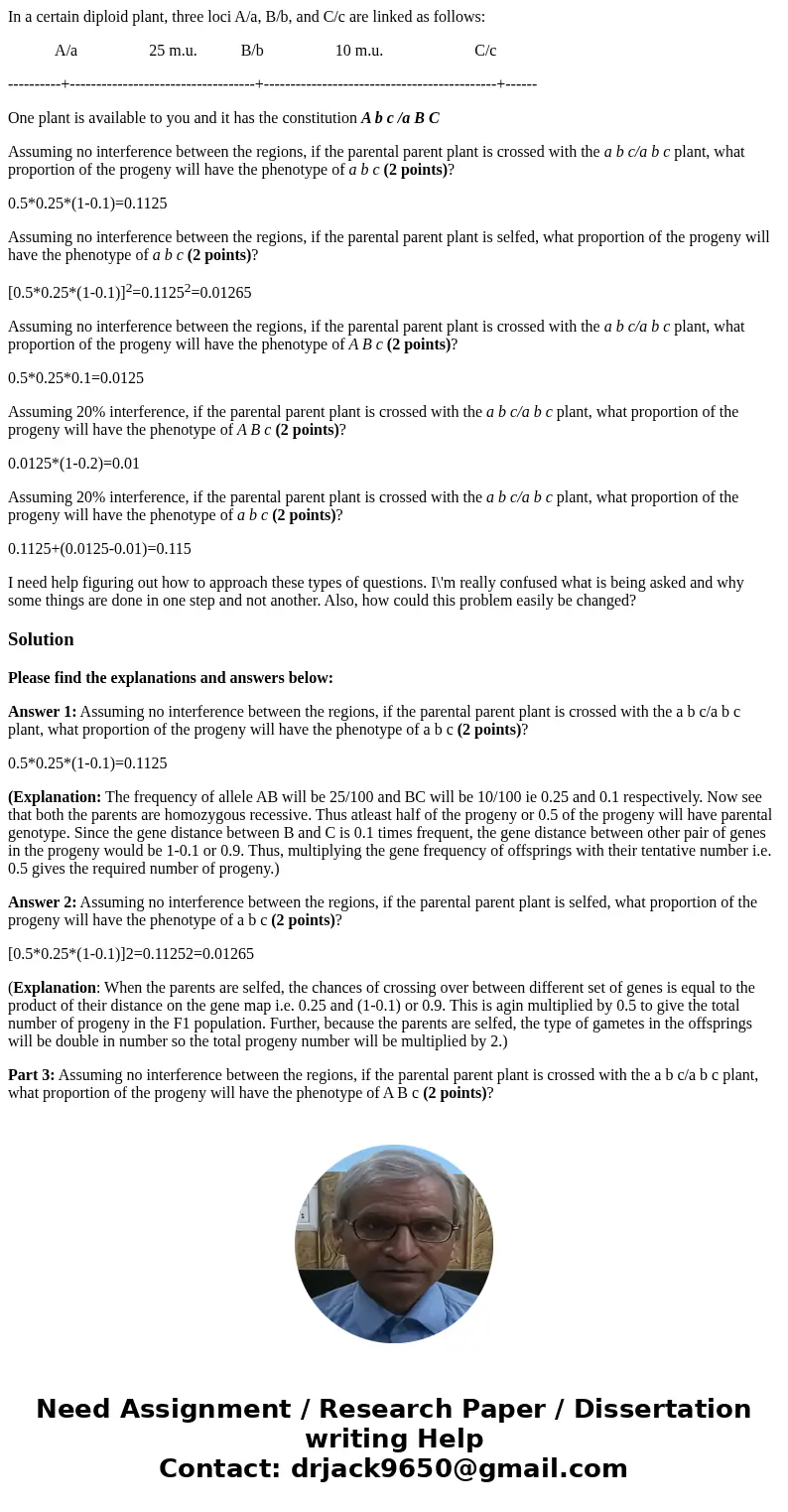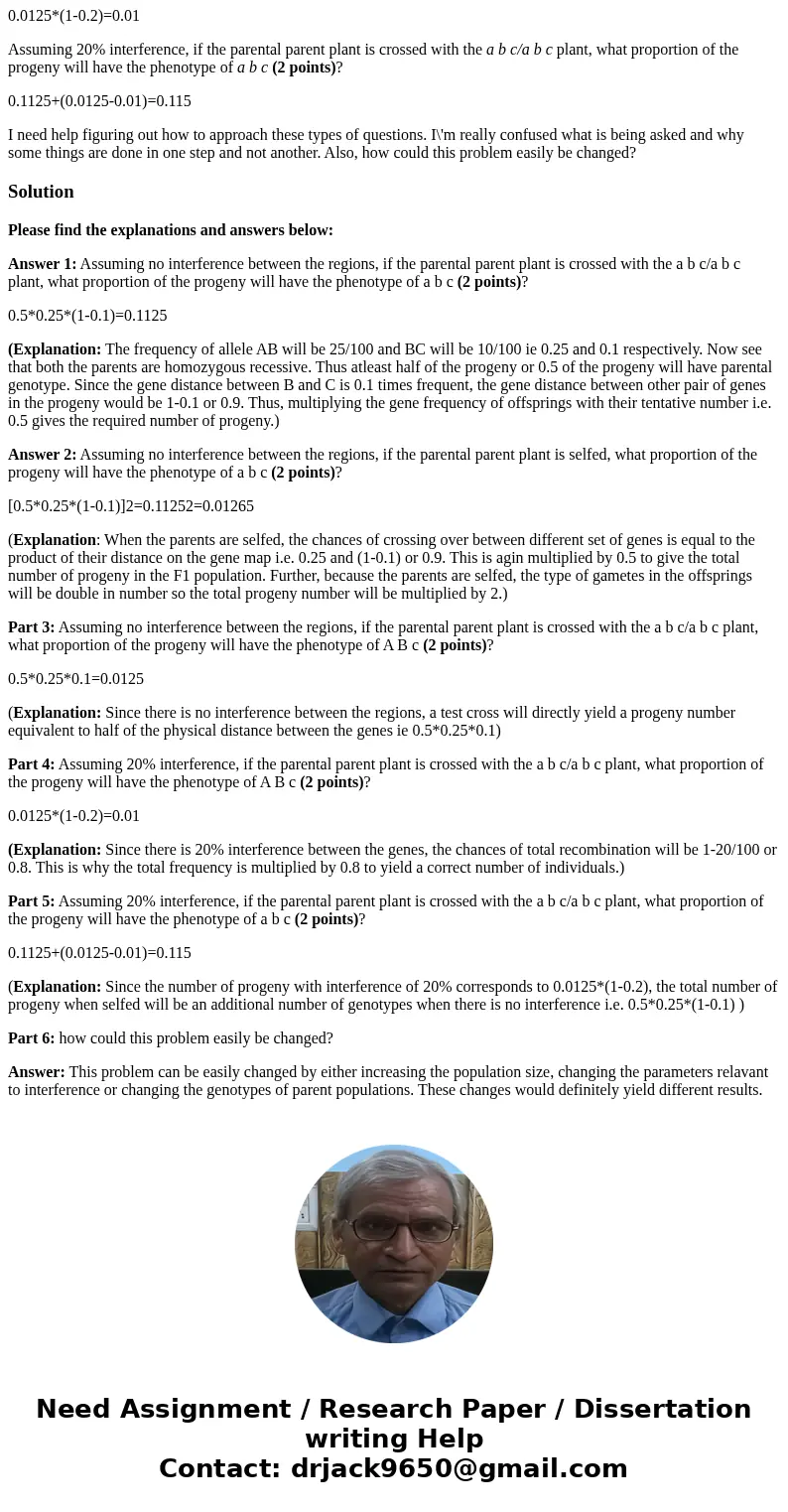In a certain diploid plant three loci Aa Bb and Cc are linke
In a certain diploid plant, three loci A/a, B/b, and C/c are linked as follows:
A/a 25 m.u. B/b 10 m.u. C/c
----------+-----------------------------------+--------------------------------------------+------
One plant is available to you and it has the constitution A b c /a B C
Assuming no interference between the regions, if the parental parent plant is crossed with the a b c/a b c plant, what proportion of the progeny will have the phenotype of a b c (2 points)?
0.5*0.25*(1-0.1)=0.1125
Assuming no interference between the regions, if the parental parent plant is selfed, what proportion of the progeny will have the phenotype of a b c (2 points)?
[0.5*0.25*(1-0.1)]2=0.11252=0.01265
Assuming no interference between the regions, if the parental parent plant is crossed with the a b c/a b c plant, what proportion of the progeny will have the phenotype of A B c (2 points)?
0.5*0.25*0.1=0.0125
Assuming 20% interference, if the parental parent plant is crossed with the a b c/a b c plant, what proportion of the progeny will have the phenotype of A B c (2 points)?
0.0125*(1-0.2)=0.01
Assuming 20% interference, if the parental parent plant is crossed with the a b c/a b c plant, what proportion of the progeny will have the phenotype of a b c (2 points)?
0.1125+(0.0125-0.01)=0.115
I need help figuring out how to approach these types of questions. I\'m really confused what is being asked and why some things are done in one step and not another. Also, how could this problem easily be changed?
Solution
Please find the explanations and answers below:
Answer 1: Assuming no interference between the regions, if the parental parent plant is crossed with the a b c/a b c plant, what proportion of the progeny will have the phenotype of a b c (2 points)?
0.5*0.25*(1-0.1)=0.1125
(Explanation: The frequency of allele AB will be 25/100 and BC will be 10/100 ie 0.25 and 0.1 respectively. Now see that both the parents are homozygous recessive. Thus atleast half of the progeny or 0.5 of the progeny will have parental genotype. Since the gene distance between B and C is 0.1 times frequent, the gene distance between other pair of genes in the progeny would be 1-0.1 or 0.9. Thus, multiplying the gene frequency of offsprings with their tentative number i.e. 0.5 gives the required number of progeny.)
Answer 2: Assuming no interference between the regions, if the parental parent plant is selfed, what proportion of the progeny will have the phenotype of a b c (2 points)?
[0.5*0.25*(1-0.1)]2=0.11252=0.01265
(Explanation: When the parents are selfed, the chances of crossing over between different set of genes is equal to the product of their distance on the gene map i.e. 0.25 and (1-0.1) or 0.9. This is agin multiplied by 0.5 to give the total number of progeny in the F1 population. Further, because the parents are selfed, the type of gametes in the offsprings will be double in number so the total progeny number will be multiplied by 2.)
Part 3: Assuming no interference between the regions, if the parental parent plant is crossed with the a b c/a b c plant, what proportion of the progeny will have the phenotype of A B c (2 points)?
0.5*0.25*0.1=0.0125
(Explanation: Since there is no interference between the regions, a test cross will directly yield a progeny number equivalent to half of the physical distance between the genes ie 0.5*0.25*0.1)
Part 4: Assuming 20% interference, if the parental parent plant is crossed with the a b c/a b c plant, what proportion of the progeny will have the phenotype of A B c (2 points)?
0.0125*(1-0.2)=0.01
(Explanation: Since there is 20% interference between the genes, the chances of total recombination will be 1-20/100 or 0.8. This is why the total frequency is multiplied by 0.8 to yield a correct number of individuals.)
Part 5: Assuming 20% interference, if the parental parent plant is crossed with the a b c/a b c plant, what proportion of the progeny will have the phenotype of a b c (2 points)?
0.1125+(0.0125-0.01)=0.115
(Explanation: Since the number of progeny with interference of 20% corresponds to 0.0125*(1-0.2), the total number of progeny when selfed will be an additional number of genotypes when there is no interference i.e. 0.5*0.25*(1-0.1) )
Part 6: how could this problem easily be changed?
Answer: This problem can be easily changed by either increasing the population size, changing the parameters relavant to interference or changing the genotypes of parent populations. These changes would definitely yield different results.


 Homework Sourse
Homework Sourse